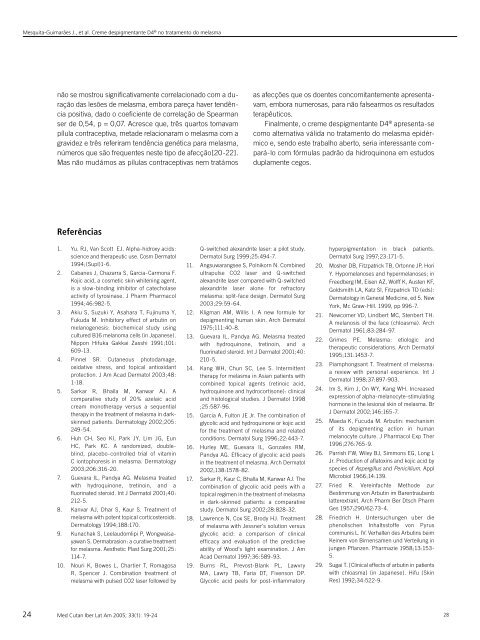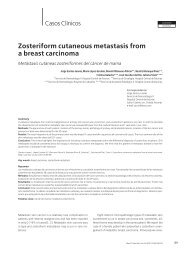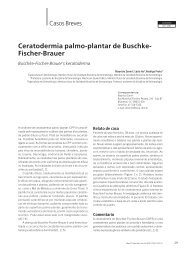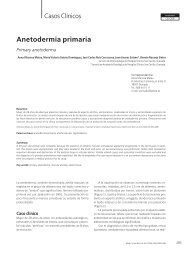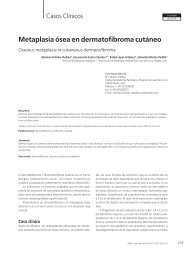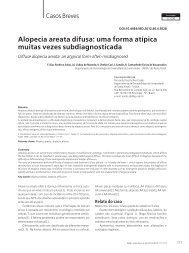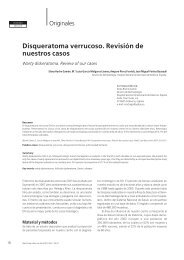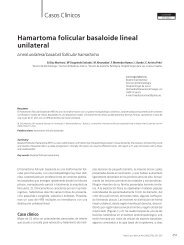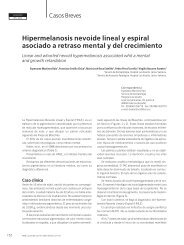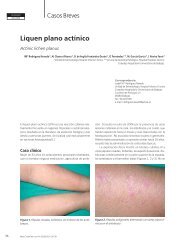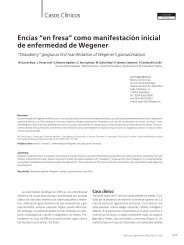Creme despigmentante D4® no tratamento do ... - Medcutan-ila.org
Creme despigmentante D4® no tratamento do ... - Medcutan-ila.org
Creme despigmentante D4® no tratamento do ... - Medcutan-ila.org
You also want an ePaper? Increase the reach of your titles
YUMPU automatically turns print PDFs into web optimized ePapers that Google loves.
Mesquita-Guimarães J., et al. <strong>Creme</strong> <strong>despigmentante</strong> D4 ® <strong>no</strong> <strong>tratamento</strong> <strong>do</strong> melasmanão se mostrou significativamente correlaciona<strong>do</strong> com a duraçãodas lesões de melasma, embora pareça haver tendênciapositiva, da<strong>do</strong> o coeficiente de correlação de Spearmanser de 0,54, p = 0,07. Acresce que, três quartos tomavampílula contraceptiva, metade relacionaram o melasma com agravidez e três referiram tendência genética para melasma,números que são frequentes neste tipo de afecção[20-22].Mas não mudámos as pílulas contraceptivas nem tratámosas afecções que os <strong>do</strong>entes concomitantemente apresentavam,embora numerosas, para não falsearmos os resulta<strong>do</strong>sterapêuticos.Finalmente, o creme <strong>despigmentante</strong> D4 ® apresenta-secomo alternativa válida <strong>no</strong> <strong>tratamento</strong> <strong>do</strong> melasma epidérmicoe, sen<strong>do</strong> este trabalho aberto, seria interessante compará-locom fórmulas padrão da hidroqui<strong>no</strong>na em estu<strong>do</strong>sduplamente cegos.Referências1. Yu. RJ, Van Scott EJ. Alpha-hidroxy acids:science and therapeutic use. Cosm Dermatol1994;(Supl)1-6.2. Cabanes J, Chazarra S, Garcia-Carmona F.Kojic acid, a cosmetic skin whitening agent,is a slow-binding inhibitor of catecholaseactivity of tyrosinase. J Pharm Pharmacol1994;46:982-5.3. Akiu S, Suzuki Y, Asahara T, Fujinuma Y,Fukuda M. Inhibitory effect of arbutin onmela<strong>no</strong>genesis: biochemical study usingcultured B16 mela<strong>no</strong>ma cells (in Japanese).Nippon Hifuka Gakkai Zasshi 1991;101:609-13.4. Pinnel SR. Cutaneous photodamage,oxidative stress, and topical antioxidantprotection. J Am Acad Dermatol 2003;48:1-18.5. Sarkar R, Bhalla M, Kanwar AJ. Acomparative study of 20% azelaic acidcream mo<strong>no</strong>therapy versus a sequentialtherapy in the treatment of melasma in darkskinnedpatients. Dermatology 2002;205:249-54.6. Huh CH, Seo KI, Park JY, Lim JG, EunHC, Park KC. A ran<strong>do</strong>mized, <strong>do</strong>ubleblind,placebo-controlled trial of vitaminC iontophoresis in melasma. Dermatology2003;206:316-20.7. Guevara IL, Pandya AG. Melasma treatedwith hydroqui<strong>no</strong>ne, treti<strong>no</strong>in, and afluorinated steroid. Int J Dermatol 2001;40:212-5.8. Kanvar AJ, Dhar S, Kaur S. Treatment ofmelasma with potent topical corticosteroids.Dermatology 1994;188:170.9. Kunachak S, Leelau<strong>do</strong>mlipi P, WongwaisayawanS. Dermabrasion: a curative treatmentfor melasma. Aesthetic Plast Surg 2001;25:114-7.10. Nouri K, Bowes L, Chartier T, RomagosaR, Spencer J. Combination treatment ofmelasma with pulsed CO2 laser followed byQ-switched alexandrite laser: a pilot study.Dermatol Surg 1999;25:494-7.11. Angsuwarangsee S, Polnikorn N. Combinedultrapulse CO2 laser and Q-switchedalexandrite laser compared with Q-switchedalexandrite laser alone for refractorymelasma: split-face design. Dermatol Surg2003;29:59-64.12. Kligman AM, Willis I. A new formule fordepigmenting human skin. Arch Dermatol1975;111:40-8.13. Guevara IL, Pandya AG. Melasma treatedwith hydroqui<strong>no</strong>ne, treti<strong>no</strong>in, and afluorinated steroid. Int J Dermatol 2001;40:210-5.14. Kang WH, Chun SC, Lee S. Intermittenttherapy for melasma in Asian patients withcombined topical agents (reti<strong>no</strong>ic acid,hydroqui<strong>no</strong>ne and hydrocortisone): clinicaland histological studies. J Dermatol 1998;25:587-96.15. Garcia A, Fulton JE Jr. The combination ofglycolic acid and hydroqui<strong>no</strong>ne or kojic acidfor the treatment of melasma and relatedconditions. Dermatol Surg 1996;22:443-7.16. Hurley ME, Guevara IL, Gonzales RM,Pandya AG. Efficacy of glycolic acid peelsin the treatment of melasma. Arch Dermatol2002;138:1578-82.17. Sarkar R, Kaur C, Bhalla M, Kanwar AJ. Thecombination of glycolic acid peels with atopical regimen in the treatment of melasmain dark-skinned patients: a comparativestudy. Dermatol Surg 2002;28:828-32.18. Lawrence N, Cox SE, Brody HJ. Treatmentof melasma with Jessner’s solution versusglycolic acid: a comparison of clinicalefficacy and evaluation of the predictiveability of Wood’s light examination. J AmAcad Dermatol 1997;36:589-93.19. Burns RL, Prevost-Blank PL, LawvryMA, Lawry TB, Faria DT, Fivenson DP.Glycolic acid peels for post-inflammatoryhyperpigmentation in black patients.Dermatol Surg 1997;23:171-5.20. Mosher DB, Fitzpatrick TB, Ortonne JP, HoriY. Hypomela<strong>no</strong>ses and hypermela<strong>no</strong>ses; inFreedberg IM, Eisen AZ, Wolff K, Austen KF,Goldsmith LA, Katz SI, Fitzpatrick TD (eds):Dermatology in General Medicine, ed 5. NewYork, Mc Graw-Hill. 1999, pp 996-7.21. Newcomer VD, Lindbert MC, Stenbert TH.A mela<strong>no</strong>sis of the face (chloasma). ArchDermatol 1961;83:284-97.22. Grimes PE. Melasma: etiologic andtherapeutic considerations. Arch Dermatol1995;131:1453-7.23. Piamphongsant T. Treatment of melasma:a review with personal experience. Int JDermatol 1998;37:897-903.24. Im S, Kim J, On WY, Kang WH. Increasedexpression of alpha-mela<strong>no</strong>cyte-stimulatinghormone in the lesional skin of melasma. BrJ Dermatol 2002;146:165-7.25. Maeda K, Fucuda M. Arbutin: mechanismof its depigmenting action in humanmela<strong>no</strong>cyte culture. J Pharmacol Exp Ther1996;276:765-9.26. Parrish FW, Wiley BJ, Simmons EG, Long LJr. Production of aflatoxins and kojic acid byspecies of Aspergillus and Penicillium. ApplMicrobiol 1966;14:139.27. Fried R. Vereinfachte Methode zurBestimmung von Arbutin im Barentraubenblatterextrakt. Arch Pharm Ber Dtsch PharmGes 1957;290/62:73-4.28. Friedrich H. Untersuchungen uber diephe<strong>no</strong>lischen Inhaltsstoffe von Pyruscommunis L. IV. Verhalten des Arbutins beimKeinem von Birnensamen und Verteilung injungen Pflanzen. Pharmazie 1958;13:153-5.29. Sugai T. [Clinical effects of arbutin in patientswith chloasma] (in Japanese). Hifu (SkinRes) 1992;34:522-9.24Med Cutan Iber Lat Am 2005; 33(1): 19-2428


